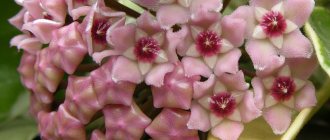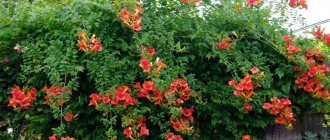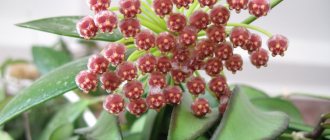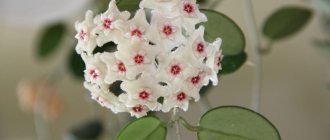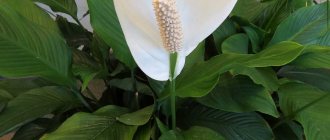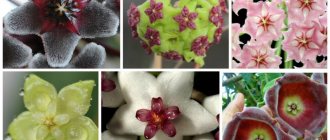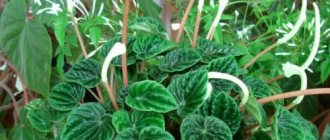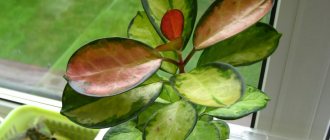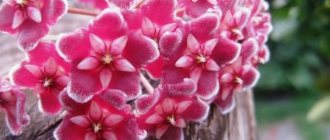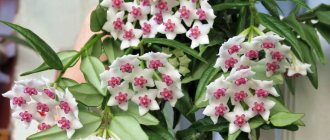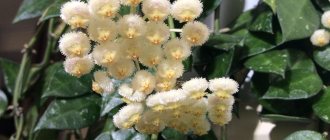Once upon a time, this evergreen ornamental plant was called “wax ivy” because of its peculiar bloom. In its natural habitat - the tropical forests of Australia - it blooms beautifully and climbs, entangling low-growing young trees. Having migrated to countries with cold climates, it is grown as a houseplant. There are more than 200 species of succulents. Some of them are giants with a varied palette of umbrella inflorescences, others are miniature creatures with barely noticeable, tiny flowers, as if created by the hands of a jeweler.
What does it look like
Hoya Carnosa belongs to the Kutrov family. Its homeland is East Asia and Australia; representatives of the Hoii genus can also be found in tropical and subtropical forests.
Hoya is a parasite because its roots penetrate the tree and feed from it. In nature, the vine can reach a length of 6 meters. The length of the leaves is from 3 to 14 cm, oval elongated shape with a pointed end.
Hoya is distinguished by beautiful sweet-smelling flowers that are collected in umbrellas
The leaves are glossy dark green, resembling satin. Hoya carnosa has long ceased to be exotic, as it is one of the most common varieties. It can be purchased in stores or at gardening centers. It is unpretentious.
Interesting! The flowers are elongated and long in shape with white petals and a star-shaped core. They smell sweet and delicious, and you can even see drops of nectar on them.
general characteristics
The second name is Hoya Fleshy; lat. Hoya carnosa.
This species can be distinguished from other varieties by several characteristics:
- has a massive, branched root system that quickly grows and fills the entire space in the pot;
- flowering occurs only after the roots have completely entwined the soil;
- the stem is curly, densely branched, the length can reach 10 m;
- the leaves are thick, fleshy, pointed at the tips, emerald green, size 8-9 cm;
- star-shaped flowers, consisting of five sharp petals, 2 cm in circumference, collected in umbrella inflorescences of 15-20 pieces.
- The color of the buds, depending on the variety, is red, snow-white, pink.
Blooms in early June and fades at the end of July. Repeated flowering begins in September. The blooming liana thins out a pleasant sweetish aroma.
The flowers are very decorative, they seem as if they are made of wax, which is why hoyas are also called wax ivy.
Signs and superstitions
This plant has a positive effect on the general condition of a person, so it can be grown in any room.
According to popular beliefs, the flower has a beneficial effect on the home atmosphere, enhances the harmony of worldview and improves family relationships, establishing connections between loved ones and relatives. It also normalizes sexual and psychological relationships between spouses.
Features of care
At home, Hoya carnosa actively grows and blooms. But for this she needs to create optimal conditions of detention.
Temperature
Hoya - types and varieties, home care
In summer, the maximum permissible temperature is 24 °C. In winter it should be lowered to 16 °C. You should not lower it below 10°C, as this will cause stress to the plant.
Important! In summer, a pot of hoya can be placed on a balcony or veranda. A change in temperature is necessary so that the hoya can gain strength to form buds.
Lighting
The plant loves bright light and will feel especially comfortable in a south-facing window. Hoya is not afraid of direct sunlight and easily tolerates it.
The plant can also be located on the north window, but additional lighting is needed for flowering. Only when suitable conditions are created can you count on flowering.
Important! As soon as the buds appear, the pot cannot be moved anywhere, otherwise the hoya will drop them.
Watering
You need to water the plant after the top layer of soil has dried 2-3 cm. For this, it is better to use filtered or settled water.
Plant growth and leaf color saturation depend on watering.
In summer, 2 waterings per week are sufficient; in winter, 1 watering per week. The pot must have a drainage system, since without it moisture will stagnate. This will lead to root rot.
Spraying
Hoya grows in tropical and subtropical forests. Therefore, it needs regular spraying. To do this, it is sprayed twice a day in the summer, and once a day in the winter. In the warm season, you can give the plant a warm shower once every two weeks. To do this, it is transferred to a bath and watered with plenty of water.
Humidity
At home, Hoya carnosa needs a high level of humidity. To do this, it is sprayed and a container of water can be placed next to the pot.
In winter, it is advisable to remove hoya from heating devices, as they contribute to dry air.
Priming
It is advisable to use ready-made soil mixture for cacti and succulents. It retains moisture well, allows air to pass through and contains nutrients.
You can prepare the mixture yourself. To do this, you need vermiculite and peat in equal parts. The components are mixed and a small amount of crushed expanded clay is added.
Feeding
Caring for Hoya carnosa is easy and even a novice gardener can handle it. Fertilizing is applied only during the flowering period and for this it is better to use special products for flowering plants.
Hoya carnosa houseplant
Houseplants are varied in appearance. They can be tall trees, bushes, vines. Some of them may bloom. Hoya carnosa is popularly called wax ivy. This plant has thick and matte leaves, as if covered with wax. Thanks to its beautiful flowers and unpretentiousness, hoya is popular among gardeners.
Plant characteristics
The Hoya family is diverse: from miniature plants to giant vines. Scientists already know about 200 varieties of wax ivy. At home, it is Hoya carnosa that is most often bred, since it feels great in apartments and offices, and when a favorable environment is created, it blooms beautifully.
Hoya carnosa (Latin name hoya carnosa) is a succulent. It has large, fleshy leaves with silver veins. There are rare plant varieties where the leaves can have different stripes:
- pink;
- red;
- yellow;
- white.
They can be located in the center or edge of the sheet. The inflorescences will include up to 20 white, star-shaped flowers. They smell delicious and release nectar over time.
The plant's homeland is Southeast Asia and Australia, and the flower received its name in honor of the botanist Thomas Hoy, who first described it.
Transplantation and propagation
Hoya can be replanted at any time of the year. But it is better not to carry out this procedure during the flowering period. The plant must be removed from the pot and left to dry for several days. Then the flower is planted in dry soil. To stimulate flowering, you need to provide hoya with a change of seasons.
Growing nemesia from seeds at home
In spring, the flower pot is placed in partial shade in the rain. At this time, the vines are pruned. In summer it can withstand heavy rain and heat. Diffused bright light stimulates the appearance of buds
At this stage, it is important not to rearrange or turn the pot over, otherwise the hoya will drop its flowers due to stress.
In autumn, the plant easily tolerates being outdoors until the air temperature drops below 10 degrees Celsius. In winter, the flower is kept at a temperature of 10 degrees Celsius in a dry room.
Hoya propagates easily - by cuttings. The easiest to harvest are stems with aerial roots (brown shoots on the vine). It is enough to cut such a cutting and plant it in moist soil.
To prevent rotting, the cut twig can be dried in air for 24 hours. The cut area is sprinkled with activated carbon powder. You can wrap the cut cuttings with damp moss.
Hoya seeds are available on sale; they are sown in moist soil in the spring. It is better to take soil consisting of sphagnum and sand. The seeds should be lightly sprinkled with soil. Usually shoots appear quickly.
Possible problems
Prolonged exposure to direct sunlight causes burns to Hoyas. They appear as brown spots on the leaves and stem. Hoya is sensitive to dampness, so the soil should dry out between waterings.
When humidity is high, the roots begin to rot, causing the plant to wither. If rotting begins, you need to transplant the flower into dry soil, after carefully clearing the roots from wet soil and removing rotten shoots.
Planting and growing perennial alpine aster
The leaves can be affected by a fungus that looks like a white coating. To combat it, you need Bordeaux mixture, which can be bought at gardening stores.
The liquid is diluted in water according to the instructions and the leaves are wiped with the resulting solution. Among the pests that affect hoya are scale insects and thrips. Insecticides are used to combat them.
The best way to prevent plant diseases is regular warm showers.
Growing in open ground
Hoya flower - what the varieties Carnosa, Kerry, Bella, fleshy, Multiflora look like
In warm weather, Hoya can be planted in open ground. During this period, you need to carefully look after her. The plant is watered three times a week in the evening, fertilizing is applied twice a month.
Important! Complex mineral products should be used as fertilizer.
When pests appear, it is necessary to spray the hoya with warm water; if this does not help, then it is worth using chemicals.
As a planting site, choose a well-lit area where there are no drafts. Before wintering, the plant is dug up and transplanted into a pot.
Transfer
When replanting, experts advise using the transshipment method, this way the roots are less damaged. Before transplanting, carefully examine how tightly the root system has filled the pot. If intertwined white roots peek out from the drainage holes, an urgent transplant is necessary. Usually, young hoya is replanted once a year, choosing a pot a couple of cm larger than the previous one. Old plants are replanted once every 3-4 years according to the description.
Replanting a plant is an important stage of care
When and how does it bloom
With proper care, Hoya carnosa begins to bloom profusely. It is thanks to this that it has become widespread throughout the world.
Hoya Kerry - home care
Features of flowers:
- Type: bell-shaped.
- The shape is tubular.
- The flowering period is from the beginning of June to the end of July, the next period lasts a month in September.
Not all owners immediately notice changes in the plant. Hoya carnosa begins to bud and immediately enters a sensitive state.
Important! During the flowering period, be sure to apply fertilizers, monitor the level of air humidity and prevent the flower from moving.
Blooming miracle
How to care for a hoya so that it pleases its owner with flowering as soon as possible? This time usually falls in the summer months, from May to September.
The secret of proper maintenance is that when brushes appear, they should not be touched, the faded umbrellas should not be cut off and replanted.
The beauty is capricious, it can drop its buds and you will have to wait a very long time for the next flowering.
Do not forget that the exotic vein spreads a strong aroma, and if they decide to move it, it will shed its flower stalks. Therefore, take care in advance about a permanent place for her.
But what to do if the gardener follows all the recommendations, but the pet does not bloom? As a rule, this period falls in the third year after rooting.
The dormant phase, like many of its flowering counterparts, occurs in winter. Then reduce watering and provide coolness. But don't overdo it. At temperatures below 12, the exotic may die.
In February-March it is time to wake him up from hibernation. Water carefully, increasing the frequency of the procedure. Spraying will not be superfluous.
To make the beauty bloom, use warm watering. To do this, place it in a deep basin or bucket, and pour lukewarm water from the shower at 35 degrees. When the water level in the container reaches the edge of the flowerpot and covers the ground, the flower is left for 1.5-2 hours.
Reproduction methods
There are several options for propagating Hoya carnosa. Most popular from cuttings, but can be eaten from the leaves or seeds. Each gardener chooses a convenient option himself.
Cuttings can be germinated in water or directly in soil
Reproduction methods:
- Through seeds - practically impossible at home, since the material can only be obtained in a nursery; germination is best carried out in mini-greenhouses at a temperature of 27°C.
- Through leaves is also a labor-intensive method. The cut leaf with petiole should be planted in the soil for succulents at an angle of 45 °. You can use special stimulants “Kornevin” and others.
- Through the upper shoots is the most convenient option. For him, it is enough to cut off the shoot with aerial roots. It needs to be planted in succulent soil and watered abundantly.
To speed up the formation of the root system, cover the pot with a glass jar or plastic bag.
Possible problems
With proper care, Hoya carnosa grows safely at home. But if containment conditions are violated, various problems can arise.
Pests
Hoya can be affected by scale insects. It is easy to detect on the outer part of the leaf, where the bugs accumulate in the form of dense brown spots with jagged edges.
The best prevention is regular warm showers
Thrips can also appear on the plant. They look like long thin brown bugs. Insecticides must be used to kill insects.
Other problems
If there is an excess of moisture, the soil becomes moldy and the leaves turn yellow. Hoya is transplanted into new soil and pot. Dark spots are the result of a burn and the affected leaves need to be removed and the flower rearranged. Small leaves and stunted growth indicate a lack of nutrients.
Diseases
Symptoms are brown or whitish spots.
The foliage turns yellow, dries, and crumbles. The control method is air humidification and insecticide treatment. Infestation with scale insects manifests itself as the appearance of fungus and cones on stems and foliage. The problem can be solved with insecticides or by treating the plant with a soap or alcohol solution. Powdery mildew on hoya, in the form of a whitish coating on the leaves and stems, is removed with insecticides in combination with regular ventilation of the room and humidification of the air. The brown nematode, which attacks the roots and stops the growth and development of the plant, is removed as a whole by washing the roots, transplanting into another sterile pot and spraying with insecticides.
Hoya Crimson Queen is a unique tropical flower. This is a wonderful case when a bizarre tropical plant felt very comfortable in our homes. Unpretentiousness combined with high decorative properties are qualities that have allowed this flower to firmly win the hearts of flower growers.
If you find an error, please select a piece of text and press Ctrl+Enter.
Hoya Carnoza is popularly called wax ivy or wax ivy. Its long lashes beautifully decorate the room. During flowering, small beautiful flowers, collected in umbrella inflorescences, exude a pleasant aroma. Since this is a fairly undemanding plant species, it can be cultivated in modern offices.
Types of flower
Based on the description of Hoya, it is easy to determine the specific variety. Among the representatives you can find plants of different shapes and colors. Such vines will be a beautiful decoration for your home.
Hoya compacta is distinguished by twisted leaves that are planted very close to each other.
Variegata has cream-colored leaves with a green edge. This variety has pink flowers. Tricolor combines the rich purple color of the leaves with a long flowering period - up to six months.
Hoya carnosa grows quickly and is easy to care for. Lianas beautifully entwine walls or special supports. With the help of such a plant you can decorate any home.
Coffee capsule Nescafe Dolce Gusto Chocochino, 3 packs of 16 capsules
1305 ₽ More details
Hot chocolate capsules Nescafe Dolce Gusto Chococino, 8 servings
334 ₽ More details
Postcards for Tatiana's Day
Varieties with photos
Hoya carnosa variegata is a slow-growing hoya that requires a little more attention than regular plant species.
If there is little scattered sunlight, it reduces its variegation. It differs from ordinary hoya in the variegated color of its leaves. Variety of Hoya variegata in the photo:
Hoya carnosa tricolor (Hoya Tricolor) - this variety has leaf blades painted in three colors:
- light green;
- creamy white;
- pink.
There are up to 30 flowers in rosettes of a pink-lilac hue.
Hoya Krimson Queen - this variety of variegated Hoya is easily recognizable by its leaf blades. Along the edge of the leaf there is a border of white or cream color. The leaf length is 7 cm. It has a rapid growth rate of green mass up to 40 cm per year. The inflorescences have pink with wine-burgundy shades. Flowering lasts from early summer to October. The aroma of flowers is unobtrusive.
